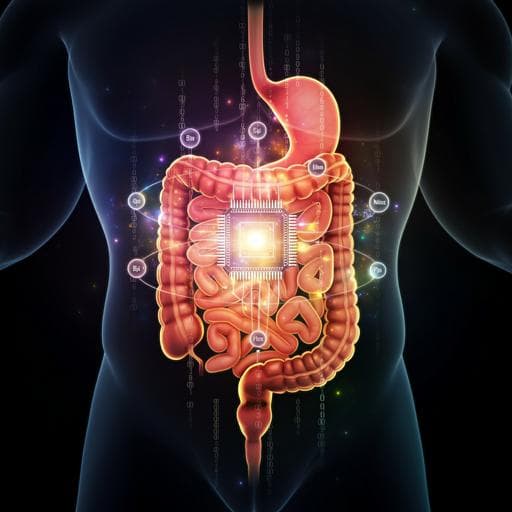
Medicine and Health
Microbiome-based correction for random errors in nutrient profiles derived from self-reported dietary assessments
T. Wang, Y. Fu, et al.
Discover METRIC, a groundbreaking deep-learning approach that enhances the accuracy of self-reported dietary assessments by correcting measurement errors using gut microbial compositions. This innovative research, conducted by Tong Wang, Yuanqing Fu, Menglei Shuai, Ju-Sheng Zheng, Lu Zhu, Andrew T. Chan, Qi Sun, Frank B. Hu, Scott T. Weiss, and Yang-Yu Liu, showcases exceptional performance in nutrient profiling consistency.
~3 min • Beginner • English
Introduction
The study addresses the challenge of measurement errors in dietary intake assessments commonly used in large epidemiologic studies (FFQ, 24-hour recalls like ASA24, and 7-day diet records). Such tools suffer from random errors (day-to-day variation) and systematic errors (misreporting, portion-size inaccuracies) that propagate into derived nutrient profiles. The authors aim to correct the random, zero-mean errors in nutrient profiles derived from single-day assessments, a problem for which existing calibration methods for habitual intake are not suitable. Inspired by image denoising approaches that learn from noisy targets (e.g., Noise2Noise), they hypothesize that combining assessed nutrient profiles with gut microbial composition can infer the underlying true nutrient profiles because diet shapes the gut microbiome and many nutrients (e.g., fibers) are metabolized by gut bacteria. The primary objective is to develop and validate METRIC, a deep-learning method that can denoise nutrient profiles without requiring ground-truth nutrient profiles during training.
Literature Review
Prior approaches to mitigate dietary assessment error include regression calibration and using cumulative averages across repeated assessments to estimate habitual intake; however, these do not correct random errors in single-day assessments. In other domains, deep neural networks have achieved strong performance in denoising tasks, but typically require clean targets. Methods like Noise2Noise learn to reconstruct clean signals from pairs of independently corrupted observations when noise is zero-mean. Nutritional and microbiome literature shows diet shapes gut microbial communities; fecal bacteria and metabolites can serve as biomarkers for certain food intakes in intervention studies. These findings motivate leveraging microbiome data as objective biomarkers to improve nutrient intake estimation.
Methodology
Overview: METRIC (Microbiome-based nutrient profile corrector) is a neural-network-based denoiser that takes as input a corrupted version of the assessed nutrient profile plus the gut microbial composition and outputs a denoised nutrient profile. Training uses only assessed nutrient profiles (treated as targets) and artificially corrupted versions of them (inputs), avoiding access to true nutrient profiles. At test time, the trained model is applied to assessed profiles (with or without microbiome) to predict values closer to the true nutrient profiles if the corruption is random and zero-mean.
Architecture and training: The core model is an MLP with 3 hidden layers (each 256 units), ReLU activations, Xavier weight initialization, and an additive skip connection from the corrupted nutrient input to the output. The final prediction is α·(corrupted nutrient input) + (1−α)·(MLP output), with α tuned via five-fold cross-validation. The loss is mean squared error. Optimization uses Adam, with early stopping when the mean Pearson correlation across nutrients on the validation set declines within the past 10 epochs. Inputs are preprocessed by centered log-ratio (CLR) transform for microbial relative abundances and log-transform for nutrient concentrations.
Training strategy (Noise2Noise-like): To avoid trivial copying, assessed nutrient profiles are further corrupted by adding random noise (e.g., Gaussian with mean 0 and SD σ or α) to create training inputs; the assessed profiles serve as targets. Because the added training noise is zero-mean and independent of the target noise, the model learns to predict the expectation, which statistically converges toward the clean signal. True nutrient profiles are never used during training.
Datasets and splits: Data were split into non-overlapping training and test sets (80/20), with five random splits for robustness. Evaluation uses the Pearson correlation coefficient ρ between predicted (corrected) and true nutrient values on the test set, averaged across nutrients.
Synthetic data generation: Using the Microbial Consumer-Resource Model (MiCRM), 250 samples were simulated with 20 nutrients and 20 microbial species. For each sample, nutrient supply rates (uniform [0,1]) define the true nutrient profile; community assembly dynamics were run to steady state to obtain microbial compositions. Assessed nutrient profiles were created by adding Gaussian noise N(0,σ²) to true profiles; corrupted inputs were generated by adding independent noise to the assessed profiles. Parameters included δ=0.1, γ=1, and species-specific consumption rates α_ia drawn from [0,10] if non-zero (50% sparsity), normalized by the number of consumable nutrients.
Real datasets and proxy ground truth: Because true nutrient profiles are unavailable in observational datasets, the following proxies were used as test-set ground truth, with artificial zero-mean noise added to create assessed profiles for evaluation:
- MCTS (n=210 paired days): ASA24-derived nutrient profiles treated as true; Gaussian noise N(0,α²) added to create assessed profiles; paired metagenomes provide microbiome compositions collected the following day.
- MLVS (n=599 paired days): One-day 7DDR-derived nutrient profiles treated as true; Gaussian noise N(0,α²) added to create assessed profiles.
- WE-MACNUTR (n=317 paired days): Nutrient profiles from complete feeding (controlled diet) treated as true; Gaussian noise N(0,α²) added to create assessed profiles.
Temporal alignment: For MCTS, diet of day t was aligned with microbiome collected the next day (t+1). Additional analyses introduced offsets Δt to test impact on performance.
Evaluation metrics and additional analyses: Primary metric is Pearson correlation ρ between predicted and true nutrient values. Reported as ρ_c (corrected vs true) and ρ_a (assessed vs true), with performance summarized by ρ_c − ρ_a or ρ_c/ρ_a across nutrients. Mean absolute error analyses mirrored correlation-based trends. Sensitivity analyses perturbed species’ abundances to estimate nutrient–species sensitivity and identify taxa plausibly linked to specific nutrient corrections. Robustness was evaluated across noise levels (e.g., α or σ = 0.5 to 2.0) and under non-zero-mean noise N(μ,σ²).
Key Findings
Synthetic (MiCRM): As Gaussian noise SD σ increased, both ρ_a and ρ_c decreased, but METRIC improved over assessed values for moderate-to-large σ, with (ρ_c − ρ_a) switching from negative to positive. At σ=1.5, multiple nutrients showed improved alignment of corrected vs true values; across nutrients, ρ_c/ρ_a > 1 for most.
MCTS (n=210; ASA24 as true): With α=1.0, mean correction performance across nutrients was (ρ_c − ρ_a)=0.079. Carotene showed minimal change (ρ_a≈0.99, ρ_c≈0.97), whereas dietary fiber improved markedly (ρ_a≈0.35 to ρ_c≈0.58). Nutrients with lower ρ_a benefited more. Without microbiome input, correction performance decreased to 0.067. Sensitivity analysis implicated taxa consistent with literature, e.g., high sensitivity of MUFAs to Bacteroides uniformis; fiber correction associated with known fiber degraders (Bacteroides plebeius, Parabacteroides sp., Bacteroides sp.).
MLVS (n=599; 7DDR as true): With α=1.0, mean (ρ_c − ρ_a)=0.072; dietary fiber again showed strong correction. Performance improved with larger noise. Analyses of day-to-day variability indicated the single-day vs 7-day-average mean ρ≈0.77 and a majority of nutrients had ρ<0.8, suggesting real-world noise levels lie in a regime where METRIC is effective.
WE-MACNUTR (n=317; complete feeding as true): With α=1.0, mean (ρ_c − ρ_a)=0.118; dietary fiber again showed substantial correction. Performance increased with noise magnitude.
Robustness and auxiliary findings: At lower noise (α=0.5), overall gains were smaller, but nutrients with low ρ_a (e.g., fiber) still improved. Mean absolute error analyses paralleled correlation-based improvements. In MLVS and WE-MACNUTR, omitting microbiome yielded correction performance comparable to including it, indicating utility even without microbiome data. Increasing temporal offset between diet and microbiome (Δt) degraded performance, supporting causally linked diet–microbiome relationships. Under non-zero-mean noise (μ>0), correction performance diminished to zero, indicating inability to remove systematic bias.
Discussion
The study demonstrates that METRIC can reduce random, zero-mean measurement errors in nutrient profiles derived from self-reported single-day dietary assessments without access to clean ground truth during training. By leveraging assessed nutrient profiles together with gut microbial composition, METRIC improves correlation with true values, especially for nutrients metabolized by gut microbiota (notably dietary fiber) and when baseline assessed-vs-true correlations are low. Synthetic experiments confirm the denoising principle, and three real datasets show consistent benefits under simulated noise, with microbiome data generally enhancing performance. Temporal offset analyses support the biological plausibility of diet–microbiome coupling. The approach extends denoising paradigms from computer vision to nutritional epidemiology, offering a practical route to mitigate random errors. Importantly, METRIC can still function without microbiome input, making it applicable when microbiome data are unavailable. However, the method does not address systematic biases and its cross-dataset generalizability depends on consistent data collection and processing.
Conclusion
METRIC provides a deep-learning framework to correct random errors in nutrient profiles inferred from self-reported single-day dietary assessments by exploiting gut microbiome information and a Noise2Noise-style training strategy that avoids clean targets. It performs well in synthetic data with known ground truth and in three real datasets with proxy ground truth, with the greatest gains for microbially metabolized nutrients such as dietary fiber and under higher noise conditions. The method remains useful even without microbiome inputs. Future work should: (1) validate against objective biomarkers and controlled feeding studies to assess real-world error correction; (2) develop strategies to address systematic (non-zero-mean) biases when paired assessed and true data are available; (3) investigate model transferability across cohorts with standardized protocols; and (4) integrate additional objective data layers (e.g., metabolomics) to further improve corrections.
Limitations
- Only random, zero-mean errors can be corrected; METRIC cannot remove systematic bias/drift (non-zero-mean noise). Performance collapses as mean noise increases.
- Requires close temporal alignment between diet assessment and microbiome sampling; performance degrades with larger offsets. FFQ-based nutrient profiles (habitual intake over months) are poorly predictable from a single fecal microbiome snapshot and are not amenable to correction by METRIC.
- Validation against objective markers (e.g., controlled feeding with biomarker readouts) was not performed due to data/resource constraints; current validation relies on synthetic data or proxy ground truth with added noise.
- Cross-dataset generalization may be limited by differences in sequencing, processing pipelines, and nutrient databases; consistent protocols are needed for reliable transfer.
- Training assumes independence and zero mean of added noise; violations of these assumptions will reduce effectiveness.
Related Publications
Explore these studies to deepen your understanding of the subject.







